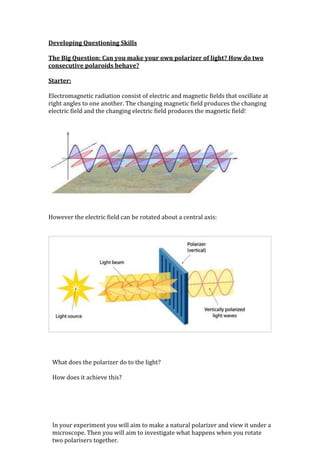
Developing questioning skills polarisation practical
- 1. Developing Questioning Skills The Big Question: Can you make your own polarizer of light? How do two consecutive polaroids behave? Starter: Electromagnetic radiation consist of electric and magnetic fields that oscillate at right angles to one another. The changing magnetic field produces the changing electric field and the changing electric field produces the magnetic field! However the electric field can be rotated about a central axis: What does the polarizer do to the light? How does it achieve this? In your experiment you will aim to make a natural polarizer and view it under a microscope. Then you will aim to investigate what happens when you rotate two polarisers together.
- 2. Practical Instructions 1. Heat the salol crystals in the test tube until they have just melted. 2. Using the dropping pipette take one drop of the molten salol and place it between the two microscope slides. 3. Place the microscope slide under the microscope fully illuminated and try and get the crystals in focus. At this point the light arriving from the light source to your eye will be polarized. Use the ideas covered in the starter to explain why the salol acts as a polariser: (HINT: what have the crystals done to the light?) ………………………………………………………………………………………………………………… ………………………………………………………………………………………………………………… ………………………………………………………………………………………………………………… 4. Now get another polarizer. Rotate it through the following angles (you will need to make sure your crystals are aligned at 0 degrees). Record the brightness of the light and estimate what fraction of the original light passing through the crystals you are ‘seeing’. Angle/degrees Fraction of original light intensity 0 45 90 135 180 If you can’t do this exactly try doing it with two ‘normal’ polarisers. When is the light intensity maximum? When is the light intensity minimum?
- 3. Which of the following graphs explains the action of two polarisers rotated relative to one another? Intensity of light Intensity of light Malus’s Law for two consecutive polarisers states: I = I0 cos2 Explain what the symbols in the equation mean and how this relates to your experiment. …………………………………………………………………………………………………………… …………………………………………………………………………………………………………… …………………………………………………………………………………………………………… …………………………………………………………………………………………………………… …………………………………………………………………………………………………………….